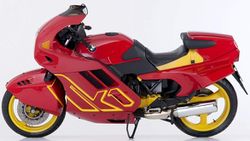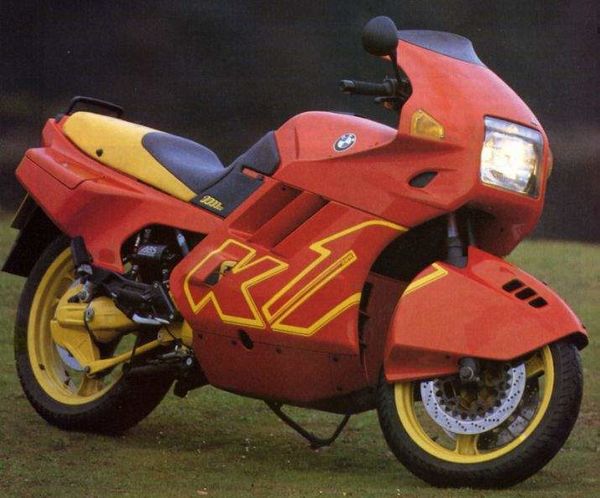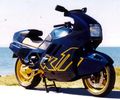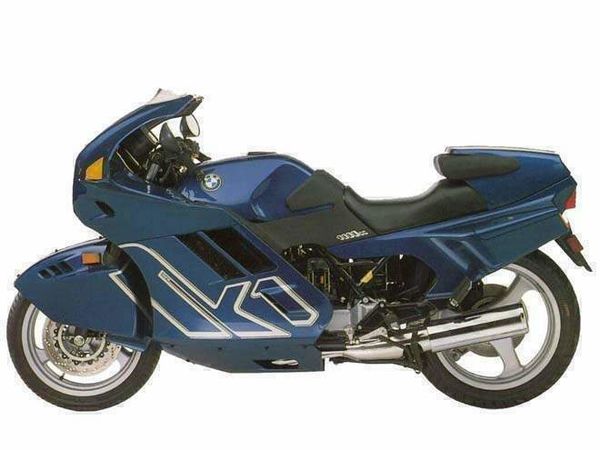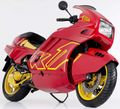BMW K1
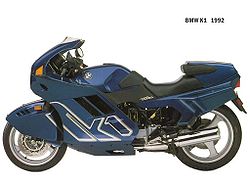 |
|
| BMW K 1 | |
| Manufacturer | |
|---|---|
| Production | 1988 - 1993 |
| Class | Sport Bike |
| Engine | in-line four, four-stroke |
| Bore / Stroke | 66.0mm x 66.0mm |
| Compression ratio | 11.0:1 |
| Top Speed | 146 mph (235 km/h) |
| Horsepower | 97.89 HP (73.0 KW) @ 8000RPM |
| Torque | 73.76 ft/lbs (100.0 Nm) @ 6750RPM |
| Spark Plug | NGK DR8EA '90-94 |
| Battery | YUASA 53030 '90-94 |
| Transmission | Gear box: 5-speed Final Drive: shaft |
| Final Drive | Shaft |
| Suspension | Front: telescopic fork with hydraulic shock absorber Rear: Paralever |
| Brakes | Front: dual disc Rear: single disc |
| Front Tire | 120/70x17 |
| Rear Tire | 160/60x18 |
| Wheelbase | 61.61 inches (1565 mm) |
| Length | 87.72 inches (2228 mm) |
| Width | 34.41 inches (874 mm) |
| Seat Height | 30.71 inches (780 mm) |
| Weight | 526.9 pounds (239.0 Kg) (dry), 234.0 kg (wet) |
| Oil Filter | K&N KN-163[1] |
| Fuel Capacity | 5.81 Gallon (22.00 Liters) |
| Manuals | Service Manual |
The BMW K 1 was a in-line four, four-stroke Sport Bike motorcycle produced by BMW between 1988 and 1993. It could reach a top speed of 146 mph (235 km/h). Max torque was 73.76 ft/lbs (100.0 Nm) @ 6750 RPM. Claimed horsepower was 97.89 HP (73.0 KW) @ 8000 RPM.
Engine[edit | edit source]
The engine was a liquid cooled in-line four, four-stroke. A 66.0mm bore x 66.0mm stroke result in a displacement of just 987.0 cubic centimeters. Fuel was supplied via a double overhead cams/twin cam (dohc).
Drive[edit | edit source]
The bike has a 5-speed transmission. Power was moderated via the dry, single plate.
Chassis[edit | edit source]
It came with a 120/70x17 front tire and a 160/60x18 rear tire. Stopping was achieved via dual disc in the front and a single disc in the rear. The front suspension was a telescopic fork with hydraulic shock absorber while the rear was equipped with a Paralever. The K 1 was fitted with a 5.81 Gallon (22.00 Liters) fuel tank. The bike weighed just 526.9 pounds (239.0 Kg). The wheelbase was 61.61 inches (1565 mm) long.
Designed in the Wind Tunnel[edit | edit source]
The classical styling of their models often incorporated carefully studied aerodynamics's, but in the extreme case of the K1, BMW; chose to ignore both current fashion and the conservative taste of their traditional clients, BMW would be guided by the functional standards dictated by wind-tunnel studies. The K1 was the final descendant in a long line that went back to Ernest Henne's streamlined record-breakers of the Thirties (174 mph in 1937) through the R100RS of 1976.
The new model utilized the existing K100 four cylinder engine, but added four valves per cylinder and twin cams working directly on bucket tappets together with a digital Motronic engine management system to the mix. The result was 100bhp at 8,000rpm, the then voluntarily imposed bhp limit for machines in Germany. In itself 100bhp was impressive but it would not deliver the performance required to elevate the machine to the "top table". In order to achieve this BMW looked to the models aerodynamics. BMW were aware that the aerodynamic drag of a motorcycle represented a ceiling that was hard to break, beyond a certain point vast increase in power achieved little in terms of increased performance unless the air flow was "cleaned up" and conversely better aerodynamics could offset lower brake horsepower figures.
The large all enveloping from mudguard, seven piece fairing and large tail unit that emerged as a result of the quest for aerodynamic efficiency not only endowed the machine with a striking appearance but resulted in a drag coefficient of 0.34 with the rider prone, at the time the lowest figure for any production motorcycle and one which, in combination with the 100bhp available resulted in a top speed approaching 160mph and a 0 to 60 time of 3.3 seconds.
Brembo brakes, partnered by an ABS system, Marzocchi forks measuring 41.7mm and a paralever suspension system adapted from that employed by the GS series machines ensured that the new model handled with a precision not normally associated with the marques products, whilst practical touches, such as the integrated "panniers" and pillion seat cover added to the motorcycles appeal.
The result was undoubtedly the finest handling and fastest BMW production motorcycle built, and served to highlight BMW's technological ability, however, the company's compliance with the voluntary 100bhp limit combined with a dry weight 234kg conspired against it. The result was arguably the finest "sports tourer" available, not an outright sports bike, which, together with a high showroom price resulted in only 6,600 being manufactured during the models five year production life.
Aerodynamically Efficient[edit | edit source]
Exhibiting a sculpted look, the K1 sported a streamlined front tire and, in wind-tunnel tests, recorded a record low drag coefficient of 0.34, The maximum speed benefited considerably: the K1 could achieve almost 150 mph on just 100 hp. A pure sporting machine, the K1 was more of a grand tourer than the replica racers the Japanese loved.It could comfortably carry a passenger, had built-in luggage lockers, and even offered 250 cubic inch baggage compartments as an option.
- Spark Plug: NGK DR8EA
1988 BMW K 1[edit | edit source]
The 1988 MY BMW K1 has, at its heart, a liquid-cooled, four-stroke, 987cc, in-line four cylinder engine mated to a five-speed manual transmission, that can produce a claimed 100 horsepower and 100 Nm of torque.
This sport-bike also comes with a telescopic front fork, a Monolever rear suspension, Brembo brakes with dual 305mm discs in the front and a single, 285mm disc in the rear, cast-aluminum wheels, a full0fairing, a dual seat, passenger grab rails, and a front fender that encloses almost half of the wheel, dencreasing wind drag.
1989 BMW K 1[edit | edit source]
The 1989 MY BMW K1 boasts standard features such as a telescopic front fork, a Monolever rear suspension, Brembo brakes with dual 305mm discs in the front and a single, 285mm disc in the rear, cast-aluminum wheels, a full0fairing, a dual seat, passenger grab rails, and a front fender that encloses almost half of the wheel, dencreasing wind drag.
In the tech/engine department, it sports a fuel-injected, four-stroke, liquid-cooled, 987cc, in-line four cylinder powerplant paired to a five-speed manual transmission, and can reach a maximum power output of 100 horsepower and 100 Nm of torque.
1990 BMW K 1[edit | edit source]
The 1990 MY BMW K1 has, at its heart, a fuel-injected, liquid-cooled, four-stroke, 987cc, transverse four cylinder engine mated to a five-speed manual transmission, that produces a claimed 100 horsepower and 100 Nm of torque. In addition, it boasts high-end features such as Brembo brakes with dual 305 mm discs in the front and a single, 285 mm disc in the rear, cast-aluminum wheels, a full of airing, a dual seat, passenger grab rails, and a front fender that encloses almost half of the wheel, dencreasing wind drag, plus a suspension package composed of a telescopic front fork and a Telelever in the rear.
1991 BMW K 1[edit | edit source]
The House of Munich has designed the 1991 MY BMW K1 for riders who make zero compromises when it comes to performance, but in a reliable and comfortable package. It comes with Brembo brakes with dual 305mm discs in the front and a single, 285mm disc in the rear, cast-aluminum wheels, a full0fairing, a dual seat, passenger grab rails, and a front fender that encloses almost half of the wheel, dencreasing wind drag, plus a suspension package composed of a telescopic front fork and a Telelever in the rear
In addition, it boasts a maximum power output of 100 horsepower and 100 Nm of torque from its fuel-injected, four-stroke, liquid-cooled, 987cc, transverse four cylinder engine paired to a five-speed manual transmission.
1992 BMW K 1[edit | edit source]
The 1992 MY BMW K1 has, at its heart, a liquid-cooled, fuel-injected, four-stroke, 987cc, in-line four cylinder powerplant mated to a five-speed manual transmission, and can produce a claimed 100 horsepower and 100 Nm of torque.
The key features for this machine would be the Brembo brakes with dual 305mm discs in the front and a single, 285mm disc in the rear, cast-aluminum wheels, a full0fairing, a dual seat, passenger grab rails, and a front fender that encloses almost half of the wheel, decreasing wind drag, plus a suspension package composed of a telescopic front fork and a Telelever in the rear.
The introduction of this new model. with its totally innovative appearance, caused a sensation, particularly since it came from BMW, normally so careful to respect its own design traditions, The astounding K1 under development since 1983 and unveiled in 1988 -was the result of BMW's constant research program.
References[edit | edit source]
- ↑ 2019 K&L Supply Co Catalog. K&L Supply Co. 2019.
| |||||||||||||||||
